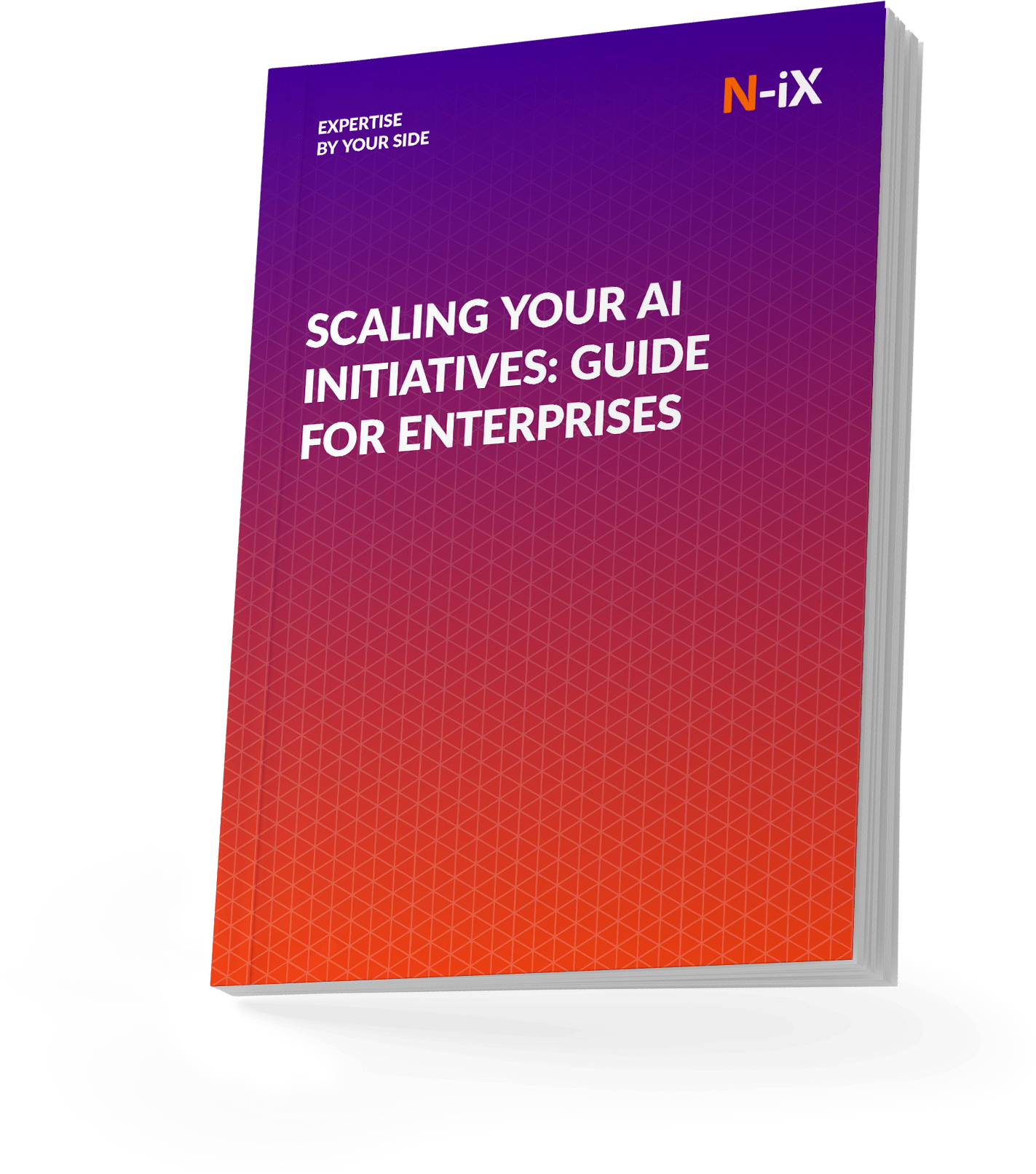Due to the increasing adoption of AI in enterprise operations, the risks associated with data privacy, ethical considerations, and regulatory compliance have become more evident. The lack of AI governance and risk management solutions is a significant barrier to AI adoption after the cost barriers. These statistics highlight a critical problem: while AI adoption is rising, effective and responsible implementation still needs to be achieved.

The core problem is the complexity of AI governance. Enterprises integrating AI, ML and Data Science encounter numerous challenges, such as confirming data quality, preventing biases, and complying with evolving regulations. Without a solid governance framework and expert AI consulting services, these issues can lead to inefficiencies, legal risks, and loss of trust from stakeholders. Moreover, unclear guidelines and lack of accountability can hinder innovation and the successful scaling of AI initiatives.
Let's delve into how enterprises can effectively address these challenges through the implementation of robust AI governance.
Defining enterprise AI governance
Enterprise AI governance integrates ethical, transparent, and accountable policies, procedures, and practices into deploying and operating AI systems. At the same time, AI initiatives align with the organization's strategic goals and values while mitigating risks and fostering trust among stakeholders. It covers traditional governance principles like policy and accountability with modern requirements such as ethics reviews, bias testing, and continuous monitoring.
AI governance can be viewed operationally through three key components: data, technique/algorithm, and business context. Each part works with various capabilities across the operating model, risk assessment, control structure, and performance monitoring.
Risk management in AI governance
Effective risk management is a key component of AI governance, vital for ensuring that AI systems operate ethically, reliably, and comply with regulations. By proactively identifying and mitigating risks, enterprises can prevent potential legal issues, protect their reputations, and ensure the fair treatment of all stakeholders.
At N-iX, we specialize in managing these risks effectively and providing robust AI governance frameworks.
Bias and fairness
One of the most significant risks associated with AI systems is bias, which can lead to unfair and discriminatory outcomes. Bias in AI can stem from unrepresentative or prejudiced training data, flawed algorithms, or inadequate testing and validation processes. This affects the fairness of decisions made by AI and can damage an enterprise's reputation.
- Training data should be diverse and representative of all relevant populations to reduce the risk of bias. For example, our team utilizes advanced data management techniques to curate comprehensive and inclusive datasets.
- Regular audits and tests are essential to identifying and rectifying biases in AI models. This includes using fairness metrics and bias detection tools to evaluate AI systems continuously. From our experience, AI teams employ the most advanced auditing tools and methodologies to ensure ongoing bias detection and correction.
- Involving diverse teams in developing and testing AI systems is important to bring multiple perspectives and reduce the risk of bias.
Data privacy issues
AI systems often require large amounts of data to function effectively, which raises significant privacy concerns. Unauthorized access to sensitive data can lead to privacy breaches, regulatory fines, and loss of trust among customers and stakeholders. Effective AI governance can address data privacy issues through:
- Implementing comprehensive data governance policies that define how data is collected, stored, used, and shared while ensuring compliance with relevant data protection regulations.
- Using data anonymization techniques to protect individual identities while still allowing meaningful analysis. Speaking from N-iX experience, we employ advanced anonymization methods to safeguard personal information without compromising the utility of the data.
- Enforcing strict access controls and authentication mechanisms for authorized personnel. For example, we implement robust access management solutions for only authorized individuals. They can access sensitive data, reducing the risk of unauthorized access.
Security vulnerabilities
AI systems can be vulnerable to different security threats, including cyberattacks, data breaches, and adversarial attacks designed to manipulate AI behavior. These vulnerabilities can compromise the integrity and reliability of AI systems, leading to significant operational and reputational damage. Mitigation strategies for security vulnerabilities include:
- Integrating AI systems into the broader cybersecurity framework. It also includes regular security assessments, penetration testing, and implementing robust encryption methods to protect data.
- Conducting adversarial testing to identify and address potential weaknesses in AI models, ensuring they can withstand attempts to deceive or manipulate them. For example, our team at N-iX employs sophisticated adversarial testing techniques to enhance the robustness of AI models.
- Developing and implementing comprehensive incident response plans to quickly address and mitigate the impact of any security breaches or attacks.
Regulatory non-compliance
Failure to comply with AI regulations can result in severe legal and financial penalties. Organizations must stay up-to-date on new and existing laws to stay in compliance. A well-implemented AI governance framework can mitigate regulatory risks by:
- Conducting regular compliance audits to ensure AI systems adhere to all relevant laws and standards.
- Incorporating ethical considerations into AI development and deployment processes. It also contains implementing transparency, accountability, and fairness in AI operations.
Operational risks
AI systems can also introduce operational risks, such as system failures, inaccuracies in decision-making, and unintended consequences that disrupt business processes. These risks can lead to financial losses, inefficiencies, and damage to customer relationships. To manage operational risks, organizations should follow:
- Rigorously testing AI systems under various scenarios before deployment to verify that they perform reliably under different conditions. Speaking from N-iX experience, we conduct thorough testing to identify potential weaknesses, and AI systems can handle real-world challenges effectively.
- Developing contingency plans to address potential failures or disruptions caused by AI systems. It mainly comprises backup systems and manual overrides to maintain operations if AI systems fail.
Best practices for implementing enterprise AI governance
Start small and scale up
Implementing AI governance can seem daunting, but beginning with specific use cases can make the process more manageable. At N-iX, we recommend focusing initially on areas where AI is already in use or where there's a clear benefit and then gradually expanding the governance framework as insights and experience are gained. This phased approach allows for iterative improvements and helps build confidence across the organization.
Learn how to scale AI initiatives across your enterprise effectively – get the guide now!


Success!

Establish a governance framework
A robust AI governance framework begins with well-defined policies and procedures that guide AI systems' development, deployment, and monitoring. These policies should outline acceptable uses of AI and data management protocols to confirm compliance with regulatory standards. At N-iX, we establish comprehensive documents that cover key elements such as roles and responsibilities, data management, model development, and deployment protocols.
Our team provides clear accountability and a roadmap for ethical and practical AI use. By coordinating across three key areas: business, risk management, and internal audit, we help organizations manage and mitigate the risks associated with AI use. Each part is aligned with best practices and regulatory requirements.
Determining AI systems within an enterprise is critical. At N-iX, we consider three approaches: balancing time, cost, and risk.
- One method is to govern only new AI systems leveraging Generative AI under existing processes. This smaller scope reduces the time and effort involved but may exclude high-risk AI systems using current Machine Learning techniques, leading to potential governance gaps.
- Another approach includes all automated decision-making systems, even those informed by direct business logic and simple calculations. This comprehensive approach covers all business processes but requires significant effort and resources.
- A third one is to control only black-box systems, including Generative AI and Machine Learning-based systems. This approach increases workloads but shares resources and procedures across similar systems.
Once the scope is defined, the next step involves creating an inventory of AI systems. Our expertise at N-iX confirms this process is thorough, covering systems across their lifecycle and business functions. We include vendor products with integrated AI, AI-specific tools (including open-source components), and tools suppliers and contractors use.
We verify that relevant information is recorded for enterprise-wide analysis, focusing on:
- Data: Source, training data, input data, and storage of outputs.
- Models: Development details, involved parties, libraries, packages, pre-trained components, assessments, testing, and reviews.
- Platform: Technical platform, on-cloud or on-premises, monitoring types, business continuity planning, and security model.
- Usage: System status, contexts of use, change management, training, and communication.
- Approvals: Access and modification rights for source data, models, and outputs, along with approval processes and logging.
- Ownership: Funding, business case, value measurement, and future development roadmap.
Build a governance framework document
At N-iX, our approach to creating a governance framework document brings together critical components such as a governance structure, clearly defined roles and responsibilities, ethical guidelines, compliance measures, and ongoing monitoring and evaluation processes. This document is the foundation for AI governance efforts, providing a precise reference point for all stakeholders. In detailing these elements, we ensure everyone understands their roles and the standards they must uphold.
Communicate and promote the value
Effective communication of AI governance principles is crucial for organizational buy-in and adherence. We prioritize transparently sharing these principles to foster a culture of accountability and trust. We also encourage cooperation between departments such as IT, legal, marketing, and operations to lead to a unified approach to AI governance.
Using internal communication channels, training sessions, and regular updates, the AI team keeps everyone informed about governance standards and practices. Emphasizing transparency aligns teams with governance objectives and enhances the organization's credibility and ethical standing, both internally and externally.
Systematically test responsible AI
Systematic testing of AI systems is essential to guarantee responsible operation and meet defined ethical standards. Our approach includes rigorous validation and verification processes to test AI models' accuracy, fairness, and reliability.
We use diverse datasets to minimize bias, conduct regular audits to identify and rectify issues and implement robust testing protocols to evaluate AI performance under different scenarios. Responsible AI testing framework helps build trust and confidence in AI systems, ensuring they deliver accurate and unbiased results that align with the organization's ethical principles.
Define roles and responsibilities
Effective AI governance is about clearly defining who is responsible for what. Key roles within the governance structure should include:
- Executive oversight: C-suite leaders, including a dedicated Chief AI or Data Officer, set the direction and priorities of AI governance, ensuring alignment with business strategy and ethical considerations.
- Ethics and compliance committees: These multidisciplinary teams develop and execute governance policies, monitor compliance, address ethical dilemmas, and navigate the complexities of AI applications.
- Legal and regulatory teams: Legal and regulatory experts interpret and implement current legislation related to AI and prepare for forthcoming legal frameworks.
- Technical teams: Data scientists and AI engineers design AI systems with governance in mind, incorporating principles like explainability and fairness into the development cycle.
- Employees and customers: Through training and awareness initiatives, we instill a culture of responsibility across all levels, including employees and end-users.
The road to responsible AI innovation
AI governance is a collective responsibility that involves every leader prioritizing accountability and ensuring responsible and ethical use of AI across the organization. Enterprise AI governance solution bridges the gap between business goals and the enterprise teams implementing them. If you seek to strengthen AI governance practices, N-iX offers expert consultation and tailored solutions.
We collaborate closely with clients to monitor, manage, and enhance their AI systems. Our team assists you in establishing clear AI governance frameworks, implementing robust monitoring and management tools, and cultivating a culture of responsible AI use. Our team of over 200 dedicated AI, Data, and ML experts has successfully executed over 60 AI projects across various sectors. Contact N-iX today to learn how we can assist your organization in enhancing its AI governance practices.
Have a question?
Speak to an expert




